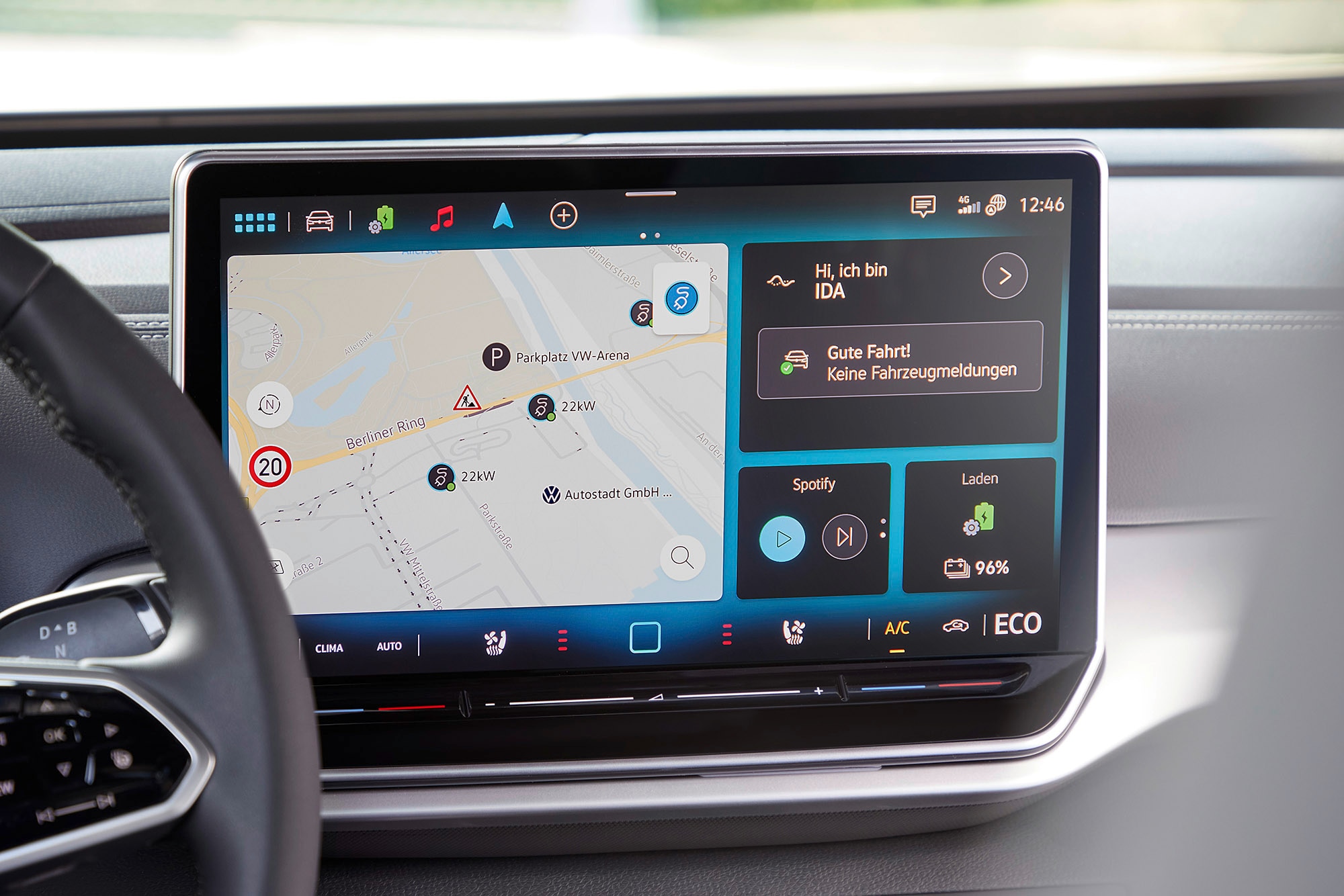What Makes a Car Infotainment System Good?
You shouldn't need a manual to figure out how to adjust the stereo volume.
 Volkswagen
Volkswagen
Despite the portmanteau name, it's neither the information nor the entertainment that really differentiates one infotainment system from the next. What matters most is how the system displays that information and provides access to entertainment features and settings. It comes down to usability.
Readability and Response Time Are Key
In its surveys of vehicle owners, Consumer Reports found that screen size matters in infotainment systems, with bigger generally translating to better. But that's not the most important factor when it comes to user satisfaction. People are often most concerned with the interface. Generally speaking, users want to know if the system is pleasing to look at and if the graphics are easy to read and navigate.
Response time to the user's taps, swipes, and pinches can vary from system to system, but quick response times can make a difference when it comes to safety. After all, time looking at a screen is time you're not watching the road.
The Best Car Infotainment Systems Mimic Smartphones
In J.D. Power's 2023 U.S. Multimedia Quality and Satisfaction Study, the research firm found that nine out of 10 infotainment issues were design related. This underscores how the industry as a whole hasn't yet hit it out of the park when it comes to this discipline. No matter how good the system's functions are — a great massaging seat, say — they won't get used if they're hard to find or difficult to operate.
Simplicity should not be confused with a lack of features; a highly capable system can be easy to use, while a more bare-bones alternative may be rendered unusable by its opaque menu structure or illogical organization.
And while a driver will get used to a system and learn its quirks over time, a good system shouldn't require extensive training. Jakob's Law of user experience — named for and devised by usability expert Jakob Nielsen — suggests that using existing mental models (i.e., paradigms users are already familiar with) speeds up the learning process and also aids in remembering a new system. So being different for the sake of it will likely just confuse and frustrate people.
Smartphone-Mirroring Tech Is Highly Valued
Choice is a good thing, as long as the choices themselves are good. If you're a smartphone user, consider looking for a vehicle with Apple CarPlay (for iPhone owners) or Android Auto (for folks with Android phones) connectivity. Bonus points go to the infotainment system that supports wireless connections to the phone for these functions instead of requiring a cable tether.
Both systems act like apps on top of the vehicle's original digital interface, allowing you to mostly pretend a subpar infotainment system doesn't exist.
Even with the widespread adoption and overwhelming popularity of these systems, the base infotainment system in a vehicle is still important, as it determines the interface's responsiveness and clarity of image. There likely are settings you can access only through the underlying manufacturer-supplied system, such as audio levels and lighting preferences.
Users Like Hard Controls for Certain Functions
Some manufacturers have translated the smartphone interactions and design cues to their in-vehicle interfaces better than others. Earlier this year, Volkswagen admitted it erred after over-enthusiastically adopting touch controls for its interiors, with CEO Thomas Schäfer conceding that the systems were frustrating to use.
So while the ID.4 electric crossover and the latest Golf models controlled various systems with haptic steering-wheel buttons, upcoming VW models will put back simpler physical controls with old-fashioned feedback.
The touch and feel matters, and nowhere is that more evident than in the middle of winter when you're trying to crank up the heat via a touchscreen while wearing gloves. Ford's hard-button-filled truck interiors are glove friendly, perhaps because they're built in part for work and people who work wear gloves.
Voice Control Has Its Limitations
Automakers have pointed to a vehicle's voice-recognition functions when the subject of menu complexity comes up. The beauty, they say, is that you don't need to know where that function is hidden or even look at the screen to adjust the cabin temperature or change the radio station because you can press a button or simply start talking and command the car to do it. Well, anyone who has tried using a virtual assistant on their phone or in their home can probably tell you that the results aren't consistently correct or useful.
Personal Preferences Count, Too
Just as there are different cars for different tastes and needs, there is no one-size-fits-all infotainment solution. That's why it's important to try before you buy as part of a test drive or while checking out a car on the showroom floor.
Bring your phone, pair it through Bluetooth, set up Apple CarPlay or Android Auto if it's available, and really try to live with the system. Make a call, ask it to play your music, get directions. Only then will you have an idea of whether this infotainment setup is right for you and worthy of your personal stamp of approval.
Written by humans.
Edited by humans.
 David Gluckman
David GluckmanDavid Gluckman has over a decade of experience as a writer and editor for print and digital automotive publications. He can parallel park a school bus, has a spreadsheet listing every vehicle he’s ever tested, and once drove a Lincoln Town Car 63 mph in reverse. When David’s not searching for the perfect used car, you can find him sampling the latest gimmicky foodstuffs that America has to offer.
Related articles
View more related articles